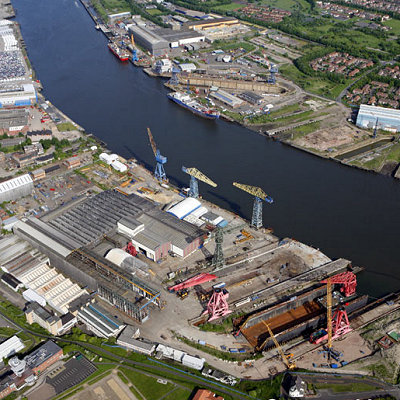
Like us on Facebook
PLACE NAMES


 
|
|
Wallsend
|
 |
| |
Several urban sanitary districts were formed in the parish in the late 19th century : Willington Quay, Howdon and Wallsend itself. The first two joined to form the Willington Quay urban district under the Local Government Act 1894, with the portion of the parish outside any urban sanitary district forming the parish of Willington in Tynemouth Rural District. Wallsend became incorporated as a municipal borough in 1901, and in 1910 took over Willington Quay and Willington, and also part of the parish of Longbenton.
Wallsend has a history of shipbuilding and was the home of the Wigham Richardson shipyard, which later amalgamated to form Swan Hunter & Wigham Richardson, probably best known for building the RMS Mauretania. This express liner held the Blue Riband, for the fastest crossing of the Atlantic, for 22 years.
Other famous ships included the RMS Carpathia which rescued the survivors from the Titanic in 1912, and the icebreaker Krasin (launched as Sviatogor) which rescued the Umberto Nobile expedition on Spitsbergen in 1928, when Roald Amundsen perished. The story is retold in the movie The Red Tent, starring Sean Connery and Peter Finch.
Charles Parsons launched his revolutionary Turbinia here in 1884, thus not only revolutionising the navies of the world, but also, through the large-scale production of affordable electricity, making a significant contribution to the modern age. He features in a BBC film called The Inventor of the Twentieth Century.
Russian novelist Yevgeny Zamyatin worked at Swan Hunter in 1916-17, and used it as background for his great anti-utopian work We which was a major influence on George Orwell's-Nineteen Eighty-Four.
WWII ships built here include HMS Sheffield and HMS Victorious which took part in the sinking of the Bismarck. Other ships built there include the new Ark Royal in the 80's
Much of Wallsend's early industry was driven by coal mining. The Wallsend Colliery consisted of 7 pits which were active between 1778 and 1935. In the 1820s the pits became incorporated as Russell's Colliery, which then became The Wallsend and Hebburn Coal Company Ltd. By 1924 the colliery employed 2183 people. Its most prominent manager was mining and railway engineer John Buddle who helped develop the Davy Lamp.
Between 1767 and 1925 there were 11 major incidents recorded at the colliery resulting in over 209 deaths. On 18 June 1835 a gas explosion in one of the tunnels killed 102 miners. The youngest was 8 years old and the oldest 75 years old. Many of the dead bodies were found with their cloth caps in their mouth. This was believed to be an attempt to stop the inhalation of the gas which eventually killed them. The bodies were extracted and buried in St.Peters churchyard at the top of the bank overlooking the Wallsend Burn. A plaque has been erected within the churchyard to commemorate this tragedy.
The town has expanded greatly in terms of housing since the end of World War II, and also since the 1960s. Wallsend Town Centre - including the main shopping area (Known as the "Wallsend Forum") - is in fact to the west of the land covered by the town. To the north of this area lies the older estate of High Farm and the new estate of Hadrian Lodge. The town centre of Wallsend is separated from the eastern areas of the town by Wallsend Burn, a stream that has cut a small valley running north-west to south-east until it flows into the River Tyne. To the east of the Burn is the old area of Holy Cross (that contains the ruins of a medieval church), the pre-war estate of Rosehill and the (mainly) post-war estate of Howdon. To the south of Howdon lies Willington Quay which, as it name suggests, once served shipping but which is now dominated by industry and housing. East Howdon forms a small enclave between Willington Quay and North Shields.
The town's principal thoroughfare and shopping street is the High Street. To the north of this street is Wallsend Green, the town's most picturesque area, consisting of large houses surrounding a green square. Behind the Green, the Burn runs through the parkland of the Hall Grounds, to Wallsend Park, a traditional British municipal park, whose restoration has frequently been demanded by local residents. Work on this restoration is due to start soon with many improvements such as a skate/BMX park, better pathways, and a rebuilding of the Duffy Memorial Fountain.
The town is home to Wallsend Boys Club, an association football club, which has produced many famous players such as Alan Shearer, Lee Clark, Peter Beardsley and Michael Carrick. It is also hometown and birthplace to internationally successful musician, Sting.
Before the last vessel was built at Wallsend in 2006, shipbuilding and most other local industries had been in decline for some 30 years, meaning that it had the sixth highest rate of unemployment in Britain by 2009 - with 13% of its residents registered unemployed.
|
 Feel free to Email me any additions or corrections Feel free to Email me any additions or corrections
LINKS AVAILABLE TO YOUR SITE
| |





